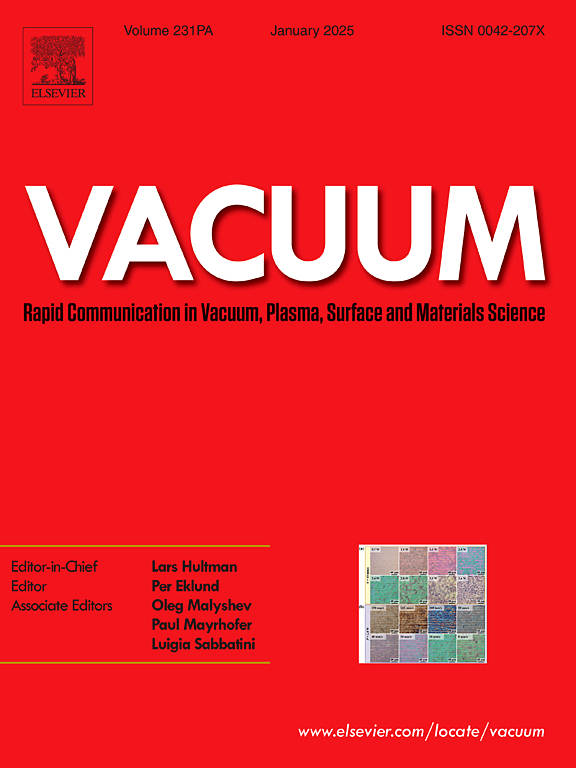AlxCoCrCuFeNi 高熵合金的热物理特性
IF 3.8
2区 材料科学
Q2 MATERIALS SCIENCE, MULTIDISCIPLINARY
引用次数: 0
摘要
通过电弧熔炼和喷射铸造技术制备了 AlxCoCrCuFeNi(x = 0.25、0.5、1、2)高熵合金(HEAs)。研究了它们的微观结构、硬度和热物理性能,如熔化焓、熵、热扩散系数、热膨胀系数等。XRD 结果表明,AlxCoCrCuFeNi(x = 0.25 和 0.5)合金由高熵 FCC 相和富铜纳米相组成。当铝含量增加到 1 和 2 时,相结构包括富铝镍的 B2 相、富铁铬的 A2 相和富铜的纳米相。随着铝含量的增加,AlxCoCrCuFeNi HEA 的微观结构从粗树枝状过渡到花瓣状树枝状,晶粒不断细化。此外,铝的添加降低了合金的密度,同时提高了维氏硬度。在 Al2CoCrCuFeNi HEA 中观察到的最大硬度约为 Al0.25CoCrCuFeNi HEA 的 2.4 倍。合金的热扩散系数最初随着温度的升高而增大,随后随着温度的升高而减小。铝含量引起的相变是使合金内部温度迅速均匀化的有效方法。此外,晶体结构、元素偏析、晶格畸变、熔焓和熔熵以及晶格振动频率都会相互影响 AlxCoCrCuFeNi HEA 的热扩散和膨胀系数。本文章由计算机程序翻译,如有差异,请以英文原文为准。
Thermophysical properties of AlxCoCrCuFeNi high entropy alloys
The AlxCoCrCuFeNi (x = 0.25, 0.5, 1, 2) high entropy alloys (HEAs) were prepared by arc melting and spray casting techniques. Their microstructures, hardness, and thermophysical properties such as fusion enthalpy, entropy, thermal diffusion coefficients, thermal expansion coefficients, were investigated. XRD results indicated that AlxCoCrCuFeNi (x = 0.25 and 0.5) alloys were composed of a high-entropy FCC phase and Cu-rich nanophase. As the Al content increased to 1 and 2, the phase structures included the AlNi-rich B2 phase, FeCr-rich A2 phase and Cu-rich nanophase. With the increased Al content, the microstructures of AlxCoCrCuFeNi HEAs transitioned from coarse dendrites to petal-like dendrites, and the grains were continuously refined. Moreover, the Al additions reduced the density whereas increased the Vickers hardness of the alloys. The maximum hardness observed in Al2CoCrCuFeNi HEA was approximately 2.4 times greater than that of the Al0.25CoCrCuFeNi HEA. The thermal diffusion coefficients of alloys initially increased and subsequently decreased as the temperature elevated. The phase transformation induced by Al content was an effective method for rapidly homogenizing the internal temperature of alloys. Furthermore, the crystal structure, elemental segregation, lattice distortion, enthalpy and entropy of fusion, and lattice vibration frequency all mutually affected the thermal diffusion and expansion coefficients of AlxCoCrCuFeNi HEAs.
求助全文
通过发布文献求助,成功后即可免费获取论文全文。
去求助
来源期刊

Vacuum
工程技术-材料科学:综合
CiteScore
6.80
自引率
17.50%
发文量
0
审稿时长
34 days
期刊介绍:
Vacuum is an international rapid publications journal with a focus on short communication. All papers are peer-reviewed, with the review process for short communication geared towards very fast turnaround times. The journal also published full research papers, thematic issues and selected papers from leading conferences.
A report in Vacuum should represent a major advance in an area that involves a controlled environment at pressures of one atmosphere or below.
The scope of the journal includes:
1. Vacuum; original developments in vacuum pumping and instrumentation, vacuum measurement, vacuum gas dynamics, gas-surface interactions, surface treatment for UHV applications and low outgassing, vacuum melting, sintering, and vacuum metrology. Technology and solutions for large-scale facilities (e.g., particle accelerators and fusion devices). New instrumentation ( e.g., detectors and electron microscopes).
2. Plasma science; advances in PVD, CVD, plasma-assisted CVD, ion sources, deposition processes and analysis.
3. Surface science; surface engineering, surface chemistry, surface analysis, crystal growth, ion-surface interactions and etching, nanometer-scale processing, surface modification.
4. Materials science; novel functional or structural materials. Metals, ceramics, and polymers. Experiments, simulations, and modelling for understanding structure-property relationships. Thin films and coatings. Nanostructures and ion implantation.
 求助内容:
求助内容: 应助结果提醒方式:
应助结果提醒方式:


